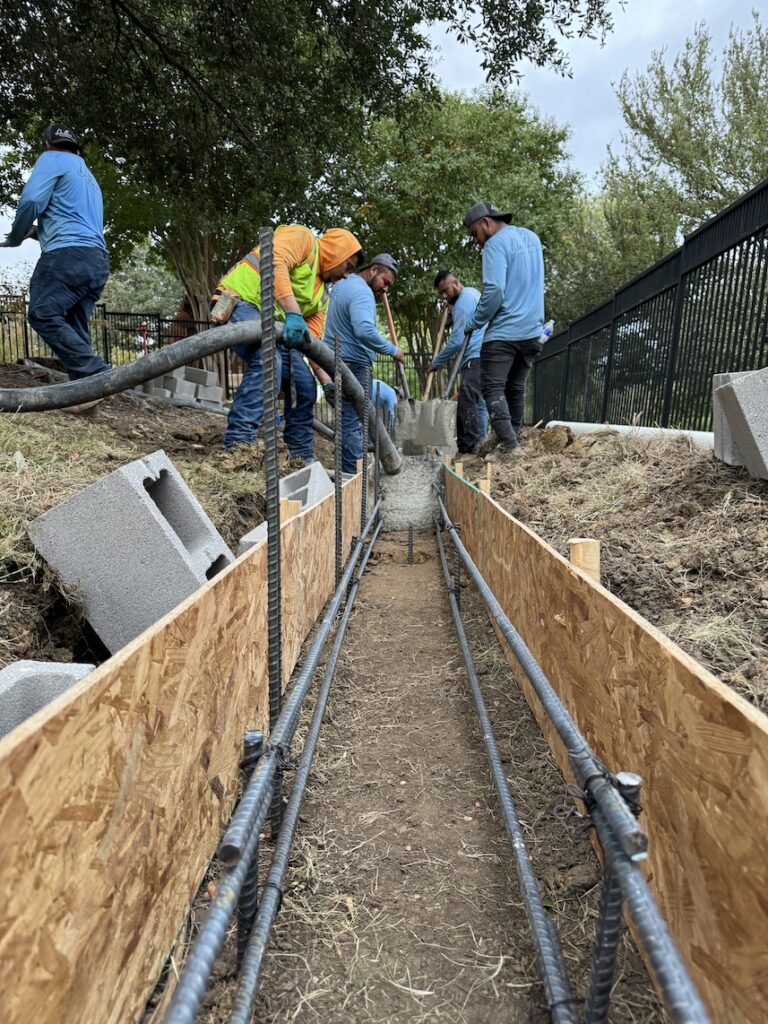Specializing in Stormwater Drainage Solutions
Retaining Walls as Drainage and Erosion Mitigation Measure
Why Hire a Drainage Company to Build a Retaining Wall?
Retaining walls are part of stormwater management. When a property is too sloped for a catch basin alone to be effective, the topography of the yard has to be reimagined. For this reason, we sometimes find ourselves on projects where a regrading job such as this is part of the solution. However, building a retaining wall involves more than stacking level blocks or stones and backfilling with soil. For a retaining wall to stay level and not fail, there is actually very specific drainage involved in the construction process.
Water is the world’s most powerful physical property, and will wear out and break down even the strongest of structures. When it comes to retaining walls, the number one reason we see them fail is due to a lack of consideration of this fact during construction. While the effects of hydrostatic pressure and erosion can be devastating to a retaining wall, if mitigated properly, a retaining wall can last a lifetime and longer. At Dallas Drainage Pros, more than anything we understand water. With our team’s extensive experience in stormwater and groundwater management, we will construct a strong retaining wall with the best drainage possible.
Retaining Wall Projects:
Dallas Drainage Pros offers outstanding confidence when it comes to something as critical as building a strong retaining wall. A long-lasting retaining wall is all about proper drainage, and Dallas Drainage Pros knows exactly how thats done.













How a retaining wall can improve drainage and reduce erosion….
Retaining walls are more than just decorative additions to a yard or property—they play a vital role in managing water and soil. If you’re dealing with sloped land, drainage problems, or erosion, a retaining wall can be a game-changer. Let’s explore how these structures work and why they’re so effective at solving these common issues.
Why Poor Drainage and Erosion Are Problems
When water isn’t managed properly, it can cause serious issues:
- Flooding and Pooling: Without a way to redirect water, rain can collect in low spots, damaging your yard, foundation, or driveway.
- Soil Saturation: Too much water in the soil can make it unstable, leading to landslides or sinkholes over time.
- Erosion: Water running downhill can carry away soil, washing out plant roots and leaving behind bare, unstable land.
These problems can damage your property and even harm nearby ecosystems. That’s where retaining walls come in.
How Retaining Walls Improve Drainage
Retaining walls are designed to control water flow and prevent it from causing damage. Here’s how they help:
Direct Water Where It Needs to Go
Retaining walls guide rainwater to drainage systems, preventing it from pooling or saturating the soil. This keeps water from collecting in places where it can cause damage.Built-In Drainage Features
Most retaining walls are equipped with features to handle water, such as weep holes, a french drain and a gravel backfill. Weep holes are small openings that let water escape instead of building up behind the wall. A french drain also acts to remove excess water behind a retaining wall, reducing hydrostatic pressure. A gravel backfill then allows water to flow down the wall and out the weep holes or into the french drain.Relieving Pressure
Water trapped behind a wall creates pressure that can cause cracks or even collapse. Drainage systems built into the wall reduce this pressure, keeping everything stable.
How Retaining Walls Prevent Erosion
Erosion happens when soil gets washed or blown away, especially on slopes. Retaining walls are great at stopping this from happening:
Holding Soil in Place
Retaining walls act as barriers that keep soil from sliding downhill, even during heavy rains. This stabilizes the ground and prevents erosion.Creating Flat Spaces
On steep land, retaining walls can create terraces—flat areas that slow down water flow. With less force behind it, water is less likely to carry soil away.Adding Plants for Extra Protection
Retaining walls often work well with landscaping. Plants added to the wall or its surroundings not only look great but also help anchor the soil with their roots.Keeping Sediment Out of Waterways
By stopping soil from washing away, retaining walls help protect your driveway and walkways from becoming covered in mud and debris, as well as safeguard nearby streams, lakes, and storm drains from sediment buildup.
Other Perks of Retaining Walls
Besides solving drainage and erosion problems, retaining walls offer other benefits:
- More Usable Space: They can turn a steep hill into usable flat areas for gardening, seating, or play areas.
- Curb Appeal: With options like stone, brick, or wood, retaining walls can enhance the look of your property.
- Protection for Your Home: They help prevent soil erosion and water from damaging your home’s foundation or other structures.
The Bottom Line
If you’re struggling with poor drainage or erosion, a retaining wall might be the solution you need. These structures don’t just manage water and stabilize soil—they also improve your property’s functionality and appearance. By working with a professional to design and build a retaining wall that fits your needs, you can tackle these issues head-on and enjoy a safer, more beautiful outdoor space.



Terracing Retaining Walls:
Building a tiered system of retaining walls, also known as terracing, can provide a very stable solution to a sloped yard where erosion is a concern.


Some Videos of Recent Jobs:
Whatever your drainage problem, we’ve got you covered. We are local drainage professionals in the Dallas area, providing quality solutions to stormwater drainage issues. Whether it involves waterproofing your home, installing a French drain or sump pump, or even hanging seamless gutters, we will leave you confident that your property will withstand the next Dallas downpour!
